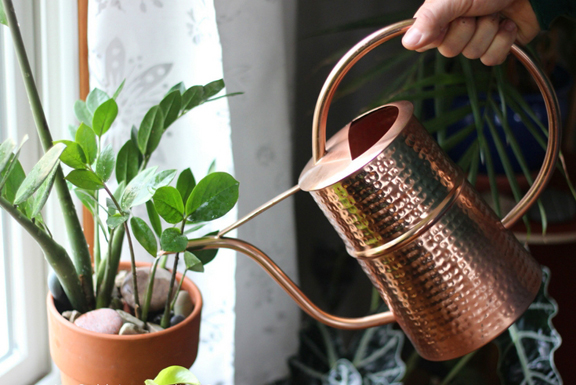
HOW TO WATER HOUSEPLANTS

If you’ve enjoyed indoor houseplants for any length of time, you’ve probably lost a plant or two.
Insufficient and excessive watering is among many reasons a plant might fail despite what seems like pampered conditions. In some cases, pampering may be precisely the problem.
Water serves as an important transport medium, allowing nutrients to travel from soil to plant cell. But too much water in the soil layer forces air from the root zone, reducing the plant’s oxygen supply.
Unfortunately, there is no simple rule dictating how often houseplants should be watered. Some plants, adapted to bog or swamp life, enjoy soaking wet conditions. Other plants–the succulent family, for example–have adapted to long periods of dryness between heavy watering. Soil medium and pot type influence how efficiently a container holds moisture.
How to evaluate soil moisture
Know the conditions you’ve given your plant to thrive in. Plants can be grown in almost any container, but some containers are better suited for plant life than others.
Clay pots are porous and tend to draw moisture from the soil, so plants in clay pots will more easily dehydrate. But if the container is enameled, or if it is metal, glass, plastic, or other non-porous material, the container will not leach moisture. Because these pots conserve water, you must be careful not to over water.
If your planter does not have drainage holes in the bottom, be sure to provide for a drainage layer of stones or other non-degradable material in which excess water can collect away from the root zone and can be gradually reabsorbed. Plants grown in closed containers may not need watering as frequently.
Peat, a natural product of bogs, is generally an ingredient of potting mixtures. A word of caution about peat-based potting mixes: peat is added for its water-retention ability. However, once allowed to dry, peat is very difficult to re-hydrate.
Learn to spot check a plant’s moisture level. If your plant is small, make a habit of picking up the plant before and after watering noting its weight change after watering. With practice, this method of checking soil moisture, together with other signs of plant vigor/weakness may help you assess a plant’s watering needs.
Similarly, a finger submerged an inch or so into the container soil should reveal a general sense of soil moisture. Or better yet, use a moisture meter. This is a foolproof, inexpensive device available at most garden centers. It will measure the soil as “wet”, “moist” or “dry”. For large container plants, a meter is almost essential.
Signs of Dehydration and Over-watering
Stem and leaf wilt signal dehydration, but you should avoid waiting for this sign. In addition, the soil mixture may pull away from the side of the pot.
Watch for these signs of dehydration:
- Leaf growth is slow.
- Leaves become translucent.
- Leaves or flowers drop prematurely.
- Leaf edges become brown and dried.
- Lower leaves curl and yellow.
Frequent watering with small amounts of water can lead to water logging. This forces air from the soil and provides ideal conditions for the growth of fungi and bacteria. These organisms attack the plant’s roots causing rot and plant death.
Certain plants thrive in wet conditions–cypress or umbrella plants, for example. Many tropical plants with thin; delicate leaves–hibiscus, for example– will not thrive in dry soil. Other plants will fail under wet conditions. A late and obvious sign of over watering is growth of fungi or mold on the soil surface.
Early signs of over-watering signs include:
- Young and old leaves fall at the same time.
- Root rot–mushy, brown possibly odorous roots–is seen in pot bottom.
- Standing water noted in the saucer.
- Flowers become moldy.
- Leaves develop brown soft rotten patches and fail to grow.
When a plant needs ample watering
Never water routinely every so many days. Water when a plant needs it. Learn about your plant’s need for water. Then adjust watering according to these general guidelines.
Plants need ample watering:
- When they are actively growing, i.e. it has young leaves or flower buds.
- If its leaves are thin and delicate and tend to brown at the tips if dry.
- When they are located in warm rooms with direct sunlight.
- If its root mass has filled its pot.
- If it is growing in a relatively small pot.
- If it is growing in dry air (i.e. forced air furnace heating, dry climate).
- If it is native to a bog or marshy area.
- If it is growing in a clay pot.
When to water sparingly
Cactus and succulents as well as plants with thick leathery leaves that do not transpire moisture heavily will suffer in wet conditions.
Similarly plants with thick fleshy roots or moisture storing structures on their roots are not to be over watered. These plants should be given just enough water to barely moisten the pot mixture throughout and should be planted in a potting medium that drains readily. Water this type of plant in several stages from the top a little each time, never watering so much that water appears through the drainage hole at the bottom.
Other times to water less:
- A plant is resting following flowering or fruiting.
- A plant is grown in a cool room.
- A plant has been repotted and its roots are re-penetrating the soil.
- A plant is grown in high humidity, for its leaves obtain moisture from the air as well as from the soil. This would be the case of plants in terrariums or greenhouses.
- A plant is grown in plastic, metal or glazed ceramic container.
- A plant is growing in a water retentive mixture, especially a soil based mixture.
- A plant’s leaves are thick and rubbery or its roots are fleshy or have water-storing structures.
How to institute self-watering
Vacations and especially busy times pose challenges for houseplant growers. If you haven’t a fellow houseplant enthusiast to lean on in these times, here are a few tricks you might implement when needed.
The moisture wick: Obtain a wick of water-absorbing material such as candlewick or old shoelaces. Remove the plant carefully from its pot, taking care to disturb the roots minimally.
With a pencil, knitting needle or other thin blunt instrument, push one end of the wick into the center of the plant’s root ball. Guide the other end through the drainage hole in the pot and replace the plant in its pot. Support the plant above some water-containing vessel, e.g. on two small 1×2 inch boards above a kitchen pot or sink. Place the wick into the water. Capillary movement of water into the pot will take place as the soil medium dries.
The capillary mat : A capillary mat is a self-watering mat made of thick felt, one portion of which is laid in the bottom of a sink, the other on a drainage board adjacent to the sink. Plants are placed atop that part of the mat on the drainage board and the sink is filled with water. Capillary mats work best for plants in plastic pots with many holes.
Clay pots should not be used with the capillary mat, as the pots will themselves absorb the moisture, transferring little to the soil medium. The wick method may be a better choice for these.
A moisture tent: After watering the plant, construct a tent over it using a dry-cleaning bag or similar clean, clear plastic material. Provide ample air space. Move the plant to a more cool location.
The tent acts to conserve water by creating a more humid environment, and the cooling reduces transipiration. The combined actions serve to lengthen the watering interval, but caution is required. This method is of value for closed-container plants when used over short periods of time. Only brief infrequent applications of this technique are recommended.
By Sheri Hunter, Colorado Master GardenerSM with Colorado State University Cooperative Extension, Denver County

